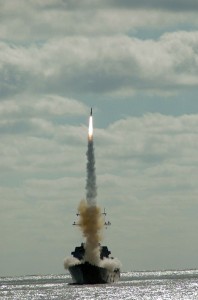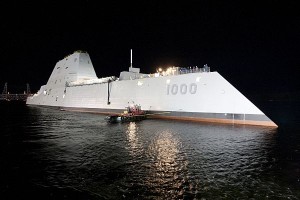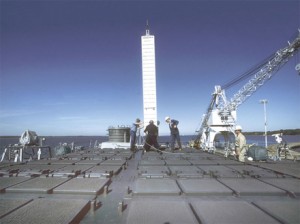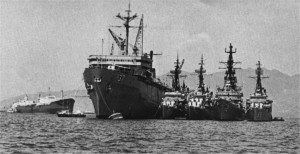 Chief of Naval Operations (CNO) Admiral Greenert’s call to put “Warfighting First” has focused attention on the Navy’s overall lack of offensive firepower. The Surface Navy, in particular, is wringing their hands over their community’s now ingrained (and almost congenital) Praetorian Guard “protect-the-carrier-or-big-deck-amphib” defensiveness, and there’s now an effort afoot to remedy things.
Chief of Naval Operations (CNO) Admiral Greenert’s call to put “Warfighting First” has focused attention on the Navy’s overall lack of offensive firepower. The Surface Navy, in particular, is wringing their hands over their community’s now ingrained (and almost congenital) Praetorian Guard “protect-the-carrier-or-big-deck-amphib” defensiveness, and there’s now an effort afoot to remedy things.
That’s good.
There’s a new and growing appreciation for surface warfare, and a widening call to reinvigorate anti-ship/anti-sub strike capability. The LCS is–supposedly–getting up-gunned or replaced entirely. New anti-ship missiles are coming. New energy-centric weapons, too. There’s more desire to operate independently, or–at a minimum–a wish to be on the ragged and dangerous edge of the larger battle network.
There’s even a sneaking concern within the Surface Navy that the commitment to maintain 11 CVN battle groups is shaky and will not be able to shield the surface combatant fleet from cuts. Aegis Ashore even reduces the need for high-profile anti-ballistic missile sea patrols. So the surface community–under attack by a cost-conscious Congress and and targeted by new air and subsurface threats–is casting about for relevance on this new maritime battlefield.
But relevance has limits. The average Surface Warfare-qualified line officer doesn’t want to be a relatively passive player, doing presence/shaping work and, if the ballon goes up, seeding the battlespace with sensors or ISR assets. They want to fight. And they want to fight like the romanticized commanders of old, lining their 80-gun frigates against a growing global fleet of other, quite capable 80-gun…er, frigates.
Exasperated sigh.
Okay.
 So there’s an effort afoot to change things. Fine. But…the Surface Navy seems to be subordinating a worthy effort to be more “offensive” under a catch-all rubric of “survivability”. That’s OK, but I do worry that “survivability” is becoming just another code word used by contractors to tug at the Navy’s heartstrings–a long over-indulged community-wide emphasis upon defense and tactical risk mitigation.
So there’s an effort afoot to change things. Fine. But…the Surface Navy seems to be subordinating a worthy effort to be more “offensive” under a catch-all rubric of “survivability”. That’s OK, but I do worry that “survivability” is becoming just another code word used by contractors to tug at the Navy’s heartstrings–a long over-indulged community-wide emphasis upon defense and tactical risk mitigation.
Take the DDG-1000. One of the oft-touted innovations is this:
“The ship is also built with a new kind of vertical launch tubes that are engineered into the hull near the perimeter of the ship. Called the Peripheral Vertical Launch System, the tubes are integrated with the hull around the ship’s periphery in order to ensure that weapons can keep firing should the ship be damaged. Instead of having all of the launch tubes in succession or near one another, the DDG 1000 has spread them out in order to mitigate risk in the event of attack..”
And that takes 80 MK 57 VLS cells (fewer than on a DDG-51) and:
“…divides the weapons up so if you take a hit, you don’t lose all your weapons. This is a survivability enhancement…”
 Good, eh? But what this fancy peripheral system does not appear to do is allow for any means of forward, austere-locale/seabase-y facilitated type of resupply.
Good, eh? But what this fancy peripheral system does not appear to do is allow for any means of forward, austere-locale/seabase-y facilitated type of resupply.
(And, to be honest, I think survivability enhancements–to enable a ship to “fight-while-hurt” on the modern battlefield is just a nice-sounding yet un-tested and unverified recipe for contractors to inflate shipbuilding costs. Look. The moment any one of our surface combatants get hit, it won’t be an effective combat asset and it’ll need to leave (or be recovered from) the battlefield–which is, in itself, a woefully under-examined, resource-sucking exercise in fleet gymnastics. I mean, getting the ostensively “still-able-t0-fight” USS Princeton off the Gulf’s gameboard during Desert Shield/Storm took a lot of work–and that’s where we had absolutely overwhelming air, surface and sub-surface superiority. Those days are over.)
So it’s a tad ironic to see this DDG-1000 “survivability” enhancement being sold as a warfighting supplement. As some might recall, one of the reasons VLS cells were originally clustered together in the first place (at least before we far-too-quickly dismissed the idea of forward VLS replenishment–I’ve written about this before here) was to FIGHT and then to KEEP FIGHTING.
Perhaps it would be wise to compare the old VLS scheme with the new one while focusing on the CNO’s Tenets: “Warfighting First”, “Operate Forward,” and “Be Ready”.
 The old idea was that if a surface combatant fired off their VLS magazine, they could go and get more missiles from a forward-deployed source (maybe at some ignored atoll, fjord or protected lee someplace), rearm and keep fighting–and that’s what I think the CNO means when he urges “Warfighting First” and “Operate Forward”.
The old idea was that if a surface combatant fired off their VLS magazine, they could go and get more missiles from a forward-deployed source (maybe at some ignored atoll, fjord or protected lee someplace), rearm and keep fighting–and that’s what I think the CNO means when he urges “Warfighting First” and “Operate Forward”.
Instead, our hot, new DDG-1000 surface combatant will, after expending a modest VLS magazine, will need to hustle out of the danger zone to an improved foreign port (!) and rearm (!!) after all the new weapons go through the host’s customs services (!!!!) and America’s ossified-to-the-point-of-impotence defense materials transferral system (AAAGH!). “Be Ready” my fanny. (And, then, you know, of course there are no opportunities for interdiction off, say, Singapore…)
It’s kinda sad to think that maintaining forward warfighting capability now depends more upon successfully navigating customs and red tape than, say, learning to steam alongside a representative of our ever-shrinking Combat Logistics Force.
Now, I’m sure this has all been fought out and war-gamed to death by the Operations guys, and that debate is raging in wardrooms throughout the Fleet And I don’t want to unfairly discount efforts to shift the advantage away from those who worship at the Sun Tzu-esque altar of “Attack First!” I just sense the Navy is putting too much importance upon poorly-validated “survivability” models during tactical engagements. And that’s OK–keeping the crew safe is of paramount importance–But survivability is a lot more complex, and it extends beyond the immediate engagement. How far out are we looking? Or are we filing logistics in a “too hard to model” category and ignoring it?
I dunno.
But, finally, at the end of the day, over-emphasizing survivability is–in my opinion–something of a poor fit with the CNO’s imperative of “Warfighting First”. It doesn’t really work.
I mean, we forget that much of the Navy we are sailing today is a product of John Lehman. And nobody–NOBODY–ever accused Mr. Lehman of favoring defense when a good offensive option was available. So, with that, I encourage the Surface Navy to work on differentiating between offensive capability and survivability, and to keep focusing on the CNO’s Tenets and Sailing Directions.

{ 14 comments… read them below or add one }
Thanks man!
Kicking myself for missing your talk last Friday, but…there’s this RFI…and not much time to respond…
Really good thinking here, Craig.
The USN has let various things atrophy since the Cold War. The new Mk 57 is a continuation what has been fleet wide on the Mk 41 for a while: no RAS crane. The same for Harpoon on Flight IIA Burkes, sub-Harpoon in SSNs, and the wholesale retirement of the TASM for more TLAMs.
For a quick improvement the Navy should restore Harpoon to subs and newer Burkes. And convert some Tomahawks for anti-ship.
VLS replenishment at sea is more about endurance and sustainability than survivability.
Survivability is important but even before 1945 it could be problematic: Jutland and British battlecruisers, the battleships Arizona and Roma.
Or use the South Dakota’s experience during Second Savo: her upper works were vulnerable to destroyer and cruiser fire. And her CO after the battle wrote about how the loss of radar during the battle demoralized the crew. He lamented the dependency of sailors on radar -in 1942!
I do think having sixty missiles dense-packed is not the best idea for survival. One hit there could lead to a catastrophic kill. Spreading out the missiles may make more sense. And the Mk 57 is larger for future missile growth.
$3 billion and its first captain is named Jim Kirk.
I dunno, but they might be raising expectations just a little too high.
The big overlooked advantage is crew size, just 142. The old USS Long Beach, CGN-9, carried over 1,100. The reliance on below-deck automation is a major test here.
I question whether the originally planned three boats will be expanded. I wouldn’t want to be a crew member as it looks like stepping outside for some fresh air would require special privileges, hall pass, note from your mother, act of congress and maybe a C-Note.
At the risk of becoming my own sort of curmudgeon, good lord does the exchanging broadsides mentality of the surface community ever make make nervous. I of course recognize that SOME ASuW capability for major surface combatants is a good idea for a plethora of reasons. But I worry that SWOs are looking at programs like LRASM and future hypersonics and pictuing their VLS cells filled with dozens upon dozens of them.
That said, “Survivability” …properly concieved and engineered…should *INCREASE* your offensive capability.
Especially if you don’t have the luxury of unit numbers.
Which is where the USN is in this century.
Thats why you can’t seperate it out.
“Being in the field, with rounds available nearby, is survival for this ship. Heading into port to reload ain’t.”
Hope you are sitting down…
Cause I couldn’t agree with you more!
You would think that the USN would understand that one overarching “Validated Requirement” for “Force Survivability” would be sustainment at sea….
Sid–
Glad to see your curmudgeonly viewpoints on survivability haven’t mellowed! Glad to see you–though I always consider one of your threads incomplete until you start riffing on the old Treaty Cruisers!
I agree with you that survivability is a balancing act, and here, in this case, I think the idea of resupply–and, as such, to keep this 16,000 ton beastie in the field, should have been a far higher priority than mounting fancy–and, as far as I can tell–hard to re-load yet safer peripheral VLS cells. Being in the field, with rounds available nearby, is survival for this ship. Heading into port to reload ain’t.
“I encourage the Surface Navy to work on differentiating between offensive capability and survivability, ”
Shows you don’t get it either…
But hey.
Take it from an expert:
http://www.nps.edu/Academics/Institutes/Meyer/docs/SI4000/Seminar_Topic/Obryon_NOv2005.ppt
“I just sense the Navy is putting too much importance upon poorly validated “survivability” models during tactical engagements. ”
The way “Validation” is being bandied about is rapidly killing credibility.
And you make my point about ignorance of the subject, and how it fits into both unit and force actions.
One more thing. I’m all for the creation of more Naval surface firepower. I read in an article the other day that if Sequestration kills the GW, the Pacific is going to be without a significant Carrier presence for longer and longer periods. It seems all of our ASuW capabilities are tied up in our CVN’s, our early flight ‘Burkes and our Tico’s. And with the latter they are using a missile that is rapidly aging and quite possibly losing effectiveness.
Without a CVN, what precisely can a Flight IIa Burke due against a missile laden Chinese Destroyer that out ranges it by alot? Not much, from what I can tell. If the no CVN situation continues and our older ‘Burkes age, we are going to have alot of vessels in the Pacific that have very short ranged weapons going up against Navy’s that have nice long range supersonic AShM’s.
What dismays me is the timetable it seems to take to get weapons now. IIRC the RFP for the Tomcat was in ’68 and the thing was on Carrier decks in ’74. The F-35C was first envisioned in what, ’01? And it isn’t likely to see Carrier decks until ’19? Similarly, Harpoon was envisioned in ’68 and on decks in ’77. LRASM started in ’09, and from what I’ve read isn’t expected to be on decks until 2024 (!).
I know weapons are more complex, but it seems other nations are able to do this faster.
I’ll admit I’m just a Civilian Navy Fanboy. So take my opinions as such. But with that caveat I’m not afraid to spew them. 🙂
For Modern survivability, I always think of the Stark. She took two Exocets and was able to get repaired to the point where she was underway under her own power the next day. I’m not sure if any of her weapons were able to operate so soon, but she didn’t sink despite extensive damage, and was repaired. I look at either LCS with the lower level build standards and the crapload of aluminum and fear they’d just burn after one Exocet hit.
I guess survivability kind of depends on what you want out of the ship. In WWII we had what were, for lack of a better word, attrition units. They had a purpose, but a more limited ability to shrug off a hit than say a BB or a CA. We had capital ships that we used both passive protection and a hell of a damage control model to keep in the fight despite horrific damage. The story of Yorktown still amazes me.
And we had some ships that weren’t designed to be overly tough, but ended up being pretty damned tough just because they used quality materiels along with simple and robust design. IIRC some DE’s and DD’s got awfully beat up and were still able to function.
So where does that leave us today? I think a Stark level of protection for a lower level combatant is good. A balance between outer defense using missiles and CIWS, and a robust ship design. And if it does get hit, lets get it back to fix it and get it back into the fight. Bigger ships like the CVN’s need alot more protection all around due to their value and how many lives they support. We should be able to find a way to have a CVN take a punch and keep going, because its that important to our warfighting model.
Ships like the DDG1000 to me are hard to quantify. Its a Gawdawful expensive ‘Destroyer’ with a wierd mix of offensive capability. You want to protect it more than its tactical value suggests just because its $3 billion a copy. For my money, you learn as much as you can off this ship for future generations and then use it if you need it in a war assuming you might lose it. Its value is in knowledge aquisition for most of its life.
And like the F4F versus the Zero at Midway…
Making your own luck in a machine that affords you a bit of time and latitdue to do so wins battles.
Same can be said of the Fletchers at Samar.
And it will matter again in this century some day.
Sure is a shame the USN is buying ships that will not allow it to happen.
“And, to be honest, I think survivability enhancements–to enable a ship to “fight-while-hurt” on the modern battlefield is just a nice-sounding yet un-tested and unverified recipe for contractors to inflate shipbuilding costs.”
First off, you are coming from a biased viewpoint as the aluminum Austal designs have inherent weaknesses when it comes to “Vulnerability Reduction”
Next, you make the usual fallacious assumption that, “Every hit is a kill”. Historically they are not. And there is no new magic today to make it so.
Nor is Survivability simply about crew survival and -hopeful- rescue.
Survivability **should** be viewed as a means to enhance mission accomplishment.
After that, its pretty embarrassing, but the senior USN leadership has no …or little…clue about “Survivability” either. Except when it comes to their egos.
Yes, 21st century ships …CAN…be designed to “Fight Hurt”. That does NOT mean they must be made indestructable.
But all the money goes into avoiding the hit…Susceptibility Reduction…which is the first priority. Problem is, thats where the money is and thats all that gets sold. And thats all that “Programs” understand.
It takes a BALANCE of Susceptability and Vulnerability Reduction design attributes…couched in the context of a sound Operational and Tactical Framework… to encompass sucessful “Survivability”